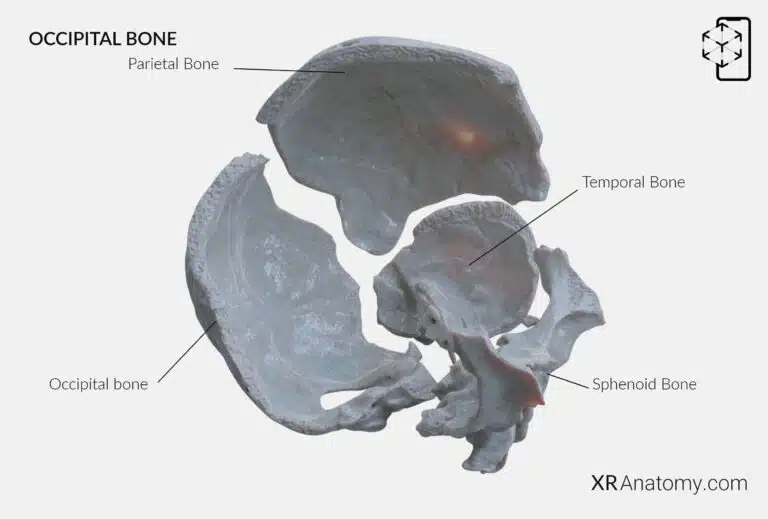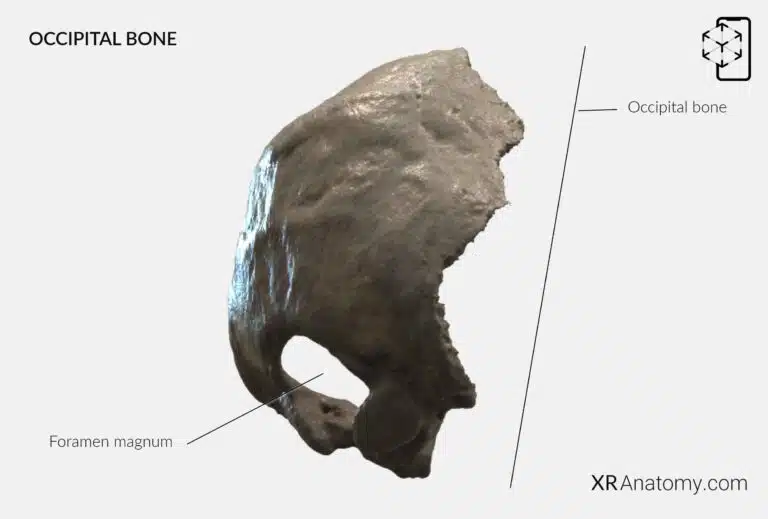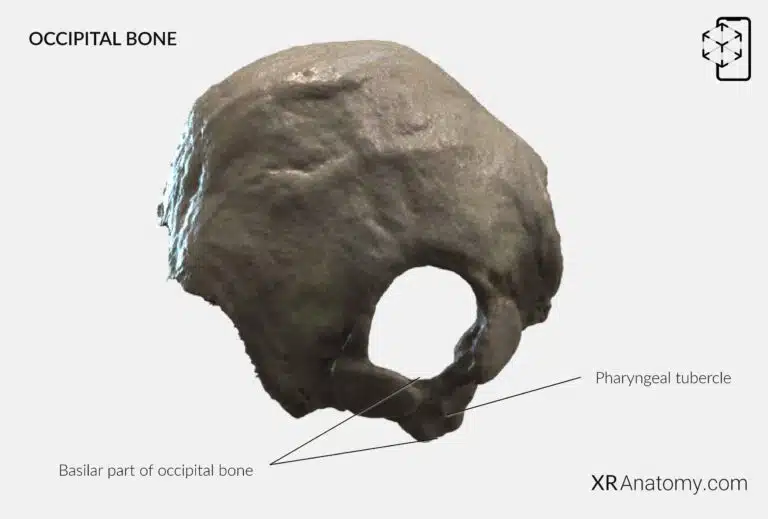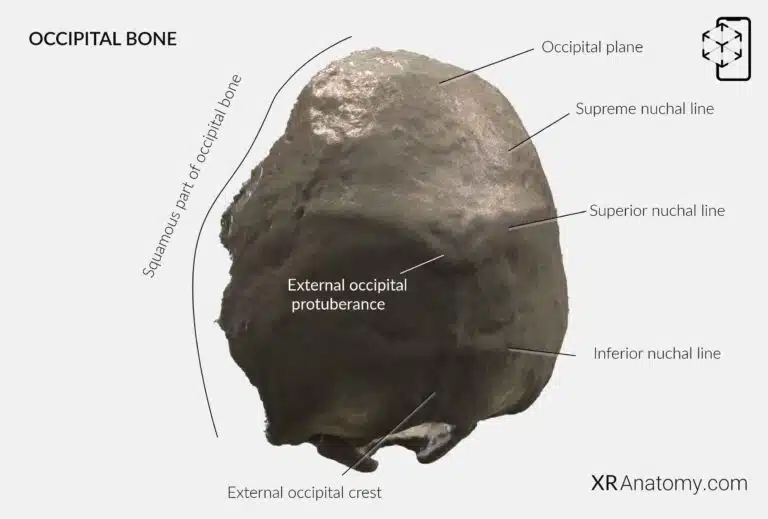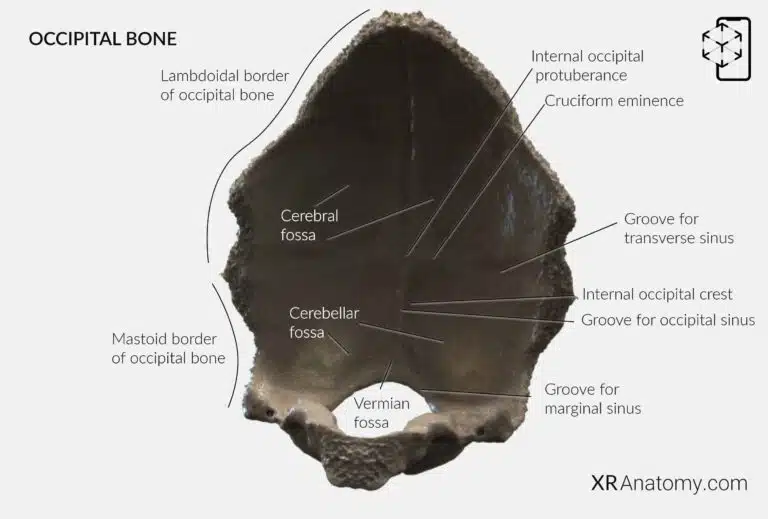OCCIPITAL BONE AR ATLAS
Interactive 3D Version Available
Explore this anatomy in full 360° rotation with our interactive 3D viewer
View in 3D →OCCIPITAL BONE

The occipital bone is a trapezoidal-shaped cranial bone located at the lower back area of the skull. It contributes significantly to the cranial cavity's posterior and inferior walls. several cranial bones, including the parietal bones, temporal bones, and the sphenoid bone, forming joints that are essential for skull integrity and brain protection.

The occipital bone is comprised of four distinct parts that encircle a large opening known as the . These parts are the squamous part, the basilar part, and two lateral parts. The foramen magnum is a crucial anatomical feature, as it allows the passage of the brainstem, connecting the medulla oblongata of the brain to the spinal cord. Additionally, it provides an entry and exit point for vital nerves and blood vessels between the cranial cavity and vertebral canal.
BASILAR PART OF OCCIPITAL BONE

The occipital bone is comprised of four distinct parts that encircle a large opening known as the . These parts are the squamous part, the basilar part, and two lateral parts. The foramen magnum is a crucial anatomical feature, as it allows the passage of the brainstem, connecting the medulla oblongata of the brain to the spinal cord. Additionally, it provides an entry and exit point for vital nerves and blood vessels between the cranial cavity and vertebral canal.
THE LATERAL PART OF THE OCCIPITAL BONE

The lateral parts of the occipital bone are situated on either side of the foramen magnum. On the inferior aspect of each lateral part are the , which are oval-shaped prominences that articulate with the first cervical vertebra (atlas), forming the atlanto-occipital joint that permits nodding movements of the head. Posterior to each condyle lies the , a depression that sometimes contains the entrance to the , a passageway for emissary veins. The originates just above the foramen magnum and extends anterolaterally to the occipital condyle, allowing the hypoglossal nerve (cranial nerve XII) to exit the cranial cavity.

The is a depression located posterior to each occipital condyle, sometimes leading into the condylar canal. The upper surface of each lateral part features the , an oval elevation that contributes to the formation of the jugular foramen. Anteriorly, the forms a portion of the jugular foramen, which transmits the internal jugular vein and several cranial nerves. The extends laterally from the occipital bone, providing attachment for muscles and ligaments. Occasionally, a bony projection called the divides the jugular notch into two parts and may contribute to forming a septum within the jugular foramen.
SQUAMOUS PART OF THE OCCIPITAL BONE
External Surface of Squamous Part

The is the largest and most posterior portion, located behind the foramen magnum. It forms the back of the skull and provides attachment sites for muscles and ligaments of the neck.
At the midline of the squamous part's external surface is the , a prominent projection that can be felt through the scalp. Extending downward from this protuberance toward the foramen magnum is the , or median nuchal line, which serves as an attachment point for the nuchal ligament.
Above the external occipital protuberance is the , a less distinct ridge. The extends horizontally on either side at the level of the external occipital protuberance, serving as an attachment for several muscles. Below it is the , another horizontal ridge that provides additional muscle attachment sites.
The area above the supreme nuchal line is known as the , contributing to the curvature of the back of the skull.

Internal Surface of Squamous Part
On the internal surface of the squamous part lies the , or cruciate eminence, a prominent structure that divides the area into four fossae—two superior and two inferior. At the center of this cross-shaped elevation is the . Extending downward from this point is the , forming the lower division of the cruciform eminence. The run horizontally on either side of the horizontal divisions, accommodating the transverse dural venous sinuses. The follows along the internal occipital crest, extending from the internal occipital protuberance to the foramen magnum, housing the occipital sinus. Additionally, the traces the inferior margin of the foramen magnum.
The superior fossae, known as the , are located on either side of the sagittal sulcus and accommodate the occipital lobes of the cerebrum. The inferior fossae, or , lie on either side of the internal occipital crest and house the hemispheres of the cerebellum. A small depression called the is situated in the lower part of the internal occipital crest, providing space for the cerebellar vermis, the central part of the cerebellum.
Related Structures
BIBLIOGRAPHY
1. Henry G, Warren HL. Osteology. In: Anatomy of the Human Body. 20th ed. Philadelphia: Lea & Febiger; 1918. p. 129–97.
2. Sampson HW, Montgomery JL, Henryson GL. Atlas of the human skull. College Station: Texas A & M University Press; 2007.
4. Saylam C, Özer MA, Ozek C, Gurler T. Anatomical Variations of the Frontal and Supraorbital Transcranial Passages. Journal of Craniofacial Surgery. 2003;14(1):10–2.
5. Hosemann W, Gross R, Goede U, Kuehnel T. Clinical anatomy of the nasal process of the frontal bone (spina nasalis interna). Otolaryngology – Head and Neck Surgery. 2001;125(1):60–5.
6. Steele DG, Bramblett CA. The anatomy and biology of human skeleton. Texas A&M University Press; 1988.
7. Tersigni-Tarrant MTA, Shirley NR. Human osteology. Vol. 4, Forensic Anthropology: An Introduction. 2012. 33–68 p.
8. Monjas-Cánovas I, García-Garrigós E, Arenas-Jiménez JJ, Abarca-Olivas J, Sánchez-Del Campo F, Gras-Albert JR. Radiological Anatomy of the Ethmoidal Arteries: CT Cadaver Study. Acta Otorrinolaringologica (English Edition). 2011;62(5):367–74.
9. Pereira G, Lopes P, Santos A, Krebs. Morphometric aspects of the jugular foramen in dry skulls of adult individuals in Southern Brazil. Vol. 27, J. Morphol. Sci. 2010.
12. Kunc V, Fabik J, Kubickova B, Kachlik D. Vermian fossa or median occipital fossa revisited: Prevalence and clinical anatomy. Annals of Anatomy. 2020 May 1;229:151458.
14. Standring S. The skull. In: Gray’s anatomy: the anatomical basis of clinical practice. 2021st ed. Elsevier Health Sciences; 2021. p. 558–73.
15. Rhoton AL. Chapter 1 Overview of Temporal Bone. Neurosurgery. 2007;
17. Tóth M, Moser G, Patonay L, Oláh I. Development of the anterior chordal canal. Annals of Anatomy. 2006;
18. Carpenter G, Knipe H. Tympanic part of temporal bone. Radiopaedia.org. 2014 Mar 23;
19. Eckerdal O. The petrotympanic fissure: A link connecting the tympanic cavity and the temporomandibular joint. Cranio – Journal of Craniomandibular Practice. 1991;9(1):15–22.
21. Singh R, Kishore Gupta N, Kumar R. Morphometry and Morphology of Foramen Petrosum in Indian Population. Basic Sciences of Medicine. 2020;2020(1):8–9.
23. Piagkou M, Xanthos T, Anagnostopoulou S, Demesticha T, Kotsiomitis E, Piagkos G, et al. Anatomical variation and morphology in the position of the palatine foramina in adult human skulls from Greece. Journal of Cranio-Maxillofacial Surgery. 2012 Oct 1;40(7):e206–10.
